This is a blog about alters and dissociation based on experiences as a system. All whom are willing to learn are welcome.
Don't wanna be here? Send us removal request.
Text
DID isn’t just about having headmates. There’s so much more to it than just that. There’s so many more symptoms that play into it than just that. It’s so much more complex than just having headmates. There’s a whole myriad of possible dissociative symptoms that are present in general. Not to mention the entire gamut of post-traumatic stress symptoms as well as tons of common comorbidities such as personality disorders, anxiety disorders, depression, addiction, eating disorders, and issues with self harm and suicidal thoughts and behaviors. It’s about memory loss, flash backs, panic attacks, depressive episodes, depersonalization, derealization, emotional numbing, emotional dysregulation, transient psychotic episodes, intrusive thoughts, physical symptoms such as headaches, body aches, gastrointestinal irritation from constant anxiety- possibly ulcers. It’s about not remembering childhood, wondering if you even had a childhood, wondering how something so horrible could happen to an innocent child, wondering why no one helped, wondering why you’re so alone, so alienated, so terrified all the time. It’s about not being able to trust other people because you can’t even trust yourself. Did that really happen? I don’t remember yesterday. I don’t remember today. Did this really happen to me? Is this really happening to me? It’s about feeling emotions that are not your own and having thoughts in your head that are disowned- that don’t belong to you- that are frightening, violent, sickening, or saddening. It’s about not knowing who or what or when or where you are. It’s about feeling hollow and empty inside. It’s about feeling crowded. It’s about feeling like there’s so much noise and so much going on inside your head that it’s killing you- you can’t escape. You can’t get it to stop. You can’t stop it. It’s about living a life of uncertainty, trying to piece together a cohesive history from bits and pieces- flashes of memories that aren’t clear or being plagued by memories that are too clear that you just wish you could forget for one day.
It’s not just about the alters. It’s so much more.
- J
2K notes
·
View notes
Text
Grounding
WHAT IS GROUNDING?
Grounding is a set of simple strategies to detach from emotional pain for example (cravings, self harm urges, emotional eating behaviour etc.) Grounding can also be a way of returning your attention to the outside world and away from yourself. In the case of dissociation.
WHY PRACTICE GROUNDING TECHNIQUES?
When you are overwhelmed with emotional pain, you need a way to detach so that you can gain control over your feelings and stay safe. As long as you are grounding, you are more likely to be able to overcome urges. Grounding ‘anchors’ you to reality.
Many people with PTSD and dissociative disorders struggle with either feeling too much (overwhelming emotions and memories) or too little (numbing and dissociation). In grounding, you attain balance between the two—conscious of reality and ability to tolerate it.
GUIDELINES:
§ Grounding can be done any time, anywhere and no one has to know.
· § Use grounding when you are: faced with a trigger, having a flashback or dissociating.
· § Keep your eyes open, look around the room, and make sure the light is good to stay in touch with the present.
· § Rate your mood before and after to test whether it worked. Before grounding, rate your level of
· § emotional pain, or your level of dissociation. Then re-rate it afterwards. Has it gone down?
· Try not to make judgements or think negatively. The idea is to distract from the negatives.
· § Stay neutral—no judgments of good or bad.
· § Focus on the present, not the past or future.
· § Grounding is much more active than relaxation exercises and focuses your attention.
Grounding is deemed to be a better way of coping with PTSD and dissociative disorders than relaxation practice. As during relaxation the focus is too much within the body, which at the worst may bring on flashbacks.
WAYS TO GROUND
MENTAL GROUNDING
o ♣ Describe to yourself in detail your surroundings: For example “The walls are white, there are three pink chairs and a blue sofa. There is a picture of a brown border collie on the wall with a gold frame around it.” You can do this out loud if appropriate, or in your head if you are in public.
o ♣ Play a game like “Scattergories” in your head or with a friend or family member. Choose a letter of the alphabet and try and come up with as many examples of a category you choose as you can. For example C … Boys names: Christopher, Curtis, Carl, Charles etc.
o ♣ Do an age progression. IThis can be particularly useful if you have dissociated or regressed to a younger alter or state. For example in my experiences I have an alter who is three. So I might say… Now I am four, I am at home with Mummy and Daddy and I can do (an example of an age appropriate activity) alone. Work your way up until you are back to your current age. This may not always work for little alters, but can help.
o ♣ Describe an everyday activity in great detail. For example if you like gardening “I open the shed door and pull out the lawn mower, I connect it to a power supply and climb on. I turn the key and put it into drive….”
o ♣ Imagine. For example make up a nice little story in your head, or out loud. “I am putting some roller skates on, and I am slowly gliding away from all my emotional suffering down a beautiful smooth lane, having fun listening to my favourite music LOUD!”
o ♣ Say a safety statement. ‘My name is _________; I am safe right now. I am in the present, not the past. I am in _____________ the date is _____________.
· ♣ Read something, saying each word to yourself. Or read each letter backwards so that you focus or the letters and not on the meaning of words.
· ♣ Use humour: For example have a “Funny Memory Bank” where you store up your favourite witty moments for those detached, rainy days.
· ♣ Count to 100 or say the alphabet very slowly or very fast.
· ♣ Repeat something meaningful to yourself, such as a prayer or quote. For example you could use the Serenity Prayer.
PHYSICAL GROUNDING
û Run cool or warm water over your hands.
û Grab tightly onto your chair as hard as you can.
· û Touch various objects around you: a pen. keys, your clothing, the table, the walls. Pay close attention to colours, weights, textures etc.
· û Firmly stamp your feet on the floor, literally grounding yourself. Feel the tension of your feet against the pressure of the floor.
· û Carry a ground object in your pocket—a small object such as a rock, stone, crystal, bead, piece of string or cloth, or a stress ball that you can touch whenever you feel triggered.
· û Jump up and down.
· û Stretch reach upwards and pull yourself tall. Extend your arms, legs, fingers and toes.
· û Walk slowly, noticing each footstep.
· û Eat something yummy. Notice the flavours, textures and feelings that come up for you.
SOOTHING GROUNDING
· ♥ Use Cheerleading statements, as if you were talking to a small child. For example “You are having a difficult time adjusting to these chanes, but you are doing so well. You should be proud of yourself.”
· ♥ Think of favorites. Think of your favorite color, animal, season, food, time of day, TV show.
· ♥ Picture people you care about. Even get a photobook made of positive pictures or pictures of people you love! Such a simple nice way to ground, and you can get A4 photo books at the moment from GroupOn for under £7!! (I in no way endorse them I just thought it was a good offer!)
· ♥ Remember the words to an inspiring song, quotation or poem that you like or feel positively about. Maybe write out the words and decorate it for your wall.
· ♥ Remember a safe place. Describe a place that you find very soothing it could be when you went on holiday to the beach, or walking in the woods. Or just a time you felt safe and peaceful at home in your living room or in bed.
· ♥ Plan out a safe treat for yourself, such as a trip to a coffee shop with a friend, making a nice dinner or a bath with some nice toiletries or candles if you feel safe to use them
· ♥ Think of things you are looking forward to in the next week. Perhaps schedule your time so you build some structure for chores and pleasurable activities. It can help to know what you are doing and also not just sit at home with nothing to do. This can cause difficulties.
WHAT IF GROUNDING DOESN’T WORK?
♠ Practice as often as possible. Even when you don’t feel overwhelmed or dissociative. This way it will come more naturally to you when you are struggling.
♠ Practice faster. Speeding up the pace gets you focused on the outside world quickly. ♠ Try grounding for a Ioooong time 20 mins at least, and then repeat !! ♠ Try to notice whether you do better with physical or mental or soothing grounding.
♠ Create your own methods of grounding. Any method you make up may be worth much more than those you read here because it is yours.
♠ Start grounding early in a negative mood cycle. Start when you begin to feel the early warning signs of dissociation or when you have just started having a flashback.
15K notes
·
View notes
Text
When an Alter Learns We Have DID
Hi all! Our therapist just broke it to our alter Mati that it is very likely we have Dissociative Identity Disorder. Matt had previously had no idea that she was not completely and totally her own person, so this obviously came as quite a shock to her: imagine someone telling you you actually share a body with your friends! We wanted to compile a list of things that helped Mati and the rest of us cope with Mati learning that it isn’t just her, in hopes that some of this might help some of you feel slightly more okay with the idea that you’re not alone in your body when you learn it:
- We are all still friends (or whatever language you use), even if we share a body; relationships are social constructs, and you constructed your relationships in whatever way you did because it’s useful! It can still be useful!
- You’re all in this together. Because you share a body, you’ve got a certain loyalty and shared responsibility. You’re a team, not fundamentally isolated.
- Whomever was “first” isn’t always necessary to know. Sometimes it can be useful, but that person isn’t “more” or “less” “real” than the rest of you just because they were original.
- Alternatively, you are not any less “you” just because there is more than one “you.” That applies to all alters, original or not.
- Everyone has a purpose. Think about your strengths. How do/can you help the system survive thrive? What about your struggles? How can the others better help you now that you know you’ve all got one body? (for Mati, this was asking for help to avoid drugs and to get a better sleep patterns, since the drugs she takes and rest she doesn’t get affects us all)
- Your system’s treatment team, friends, family, or whatever social supports you all have apply to you too. Mati was shocked to learn she too could get help from our therapist.
Any other tips welcome! Stay safe <3
85 notes
·
View notes
Photo
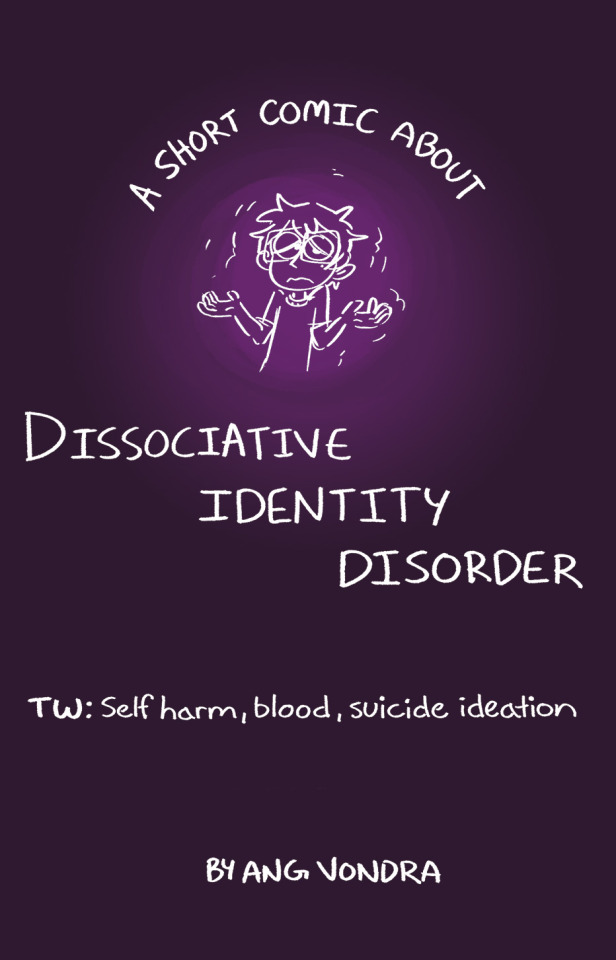
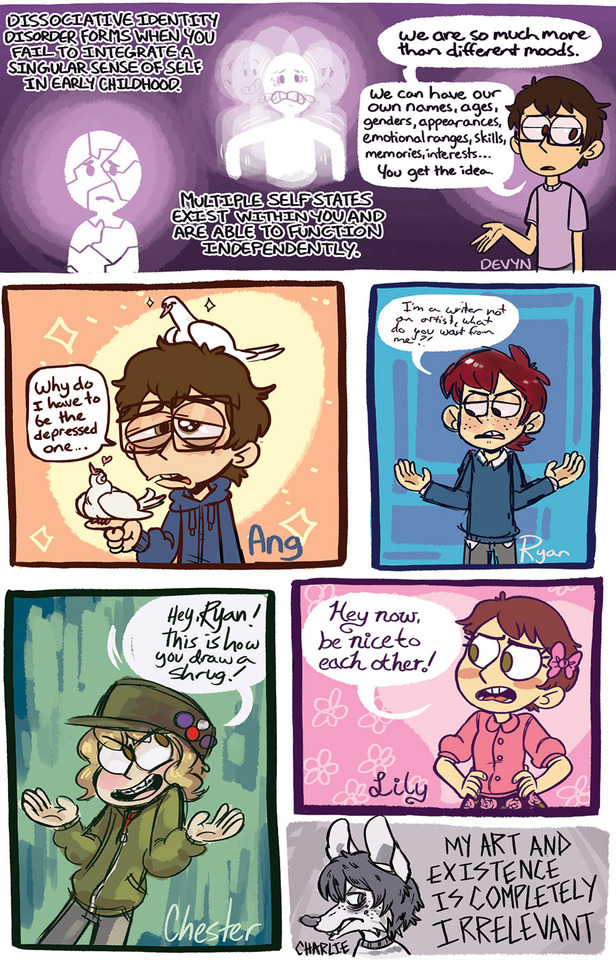
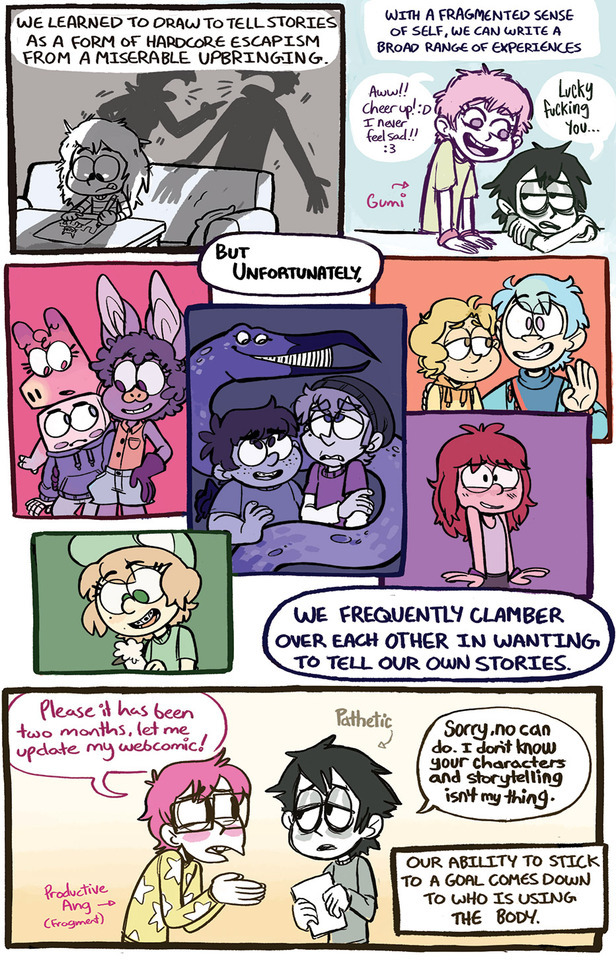
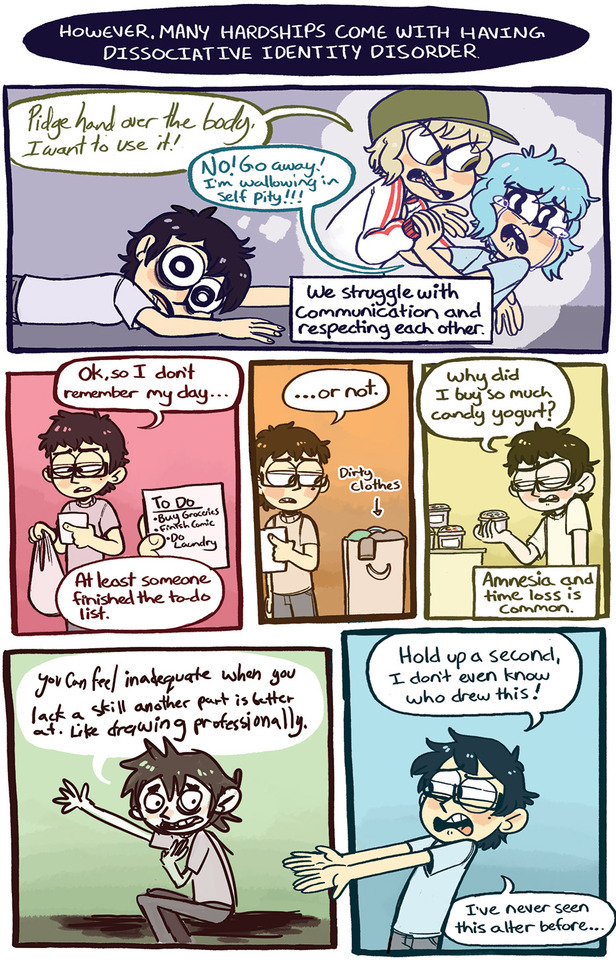
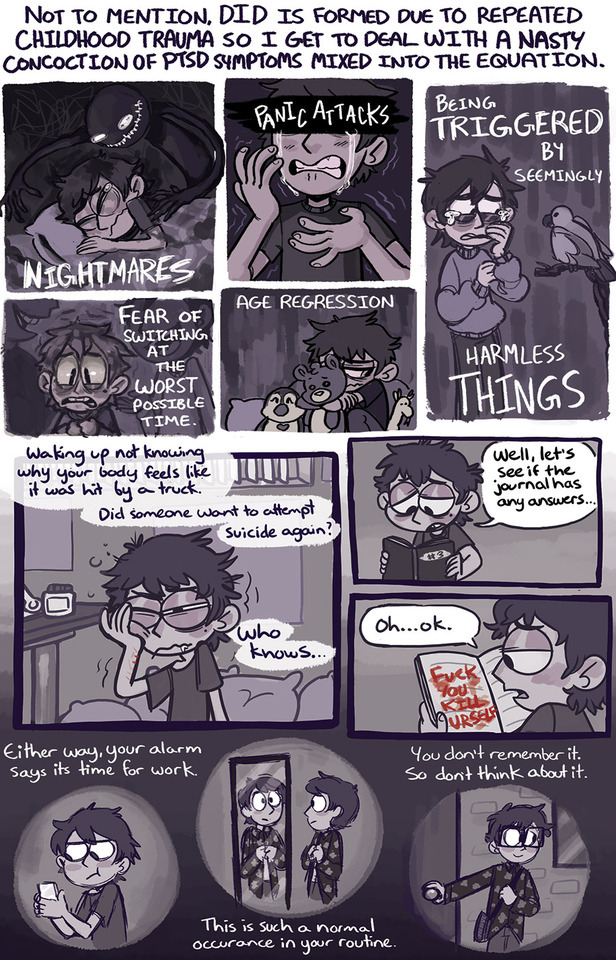
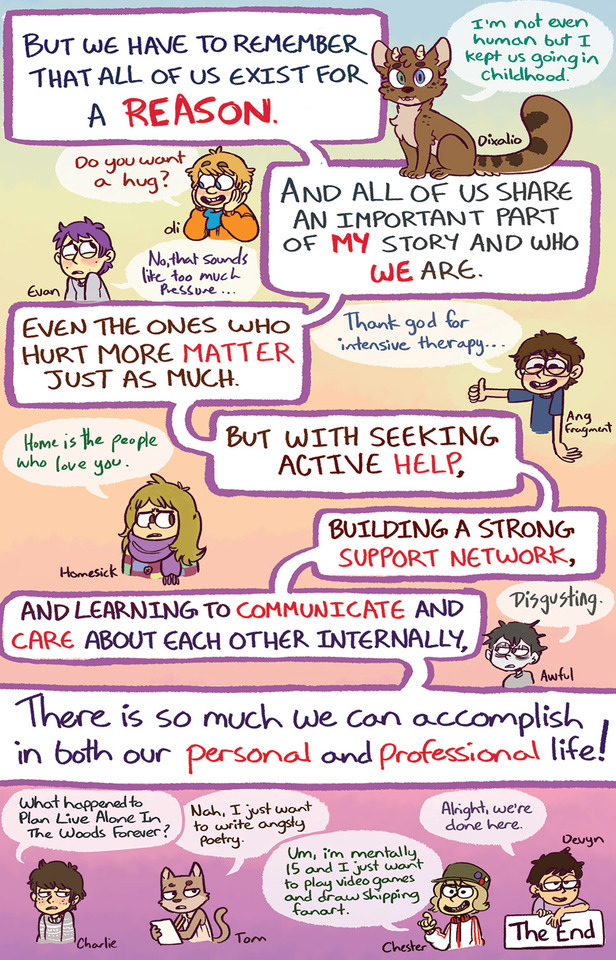
DO NOT REPOST THIS COMIC. IF YOU WANT TO SHARE IT, PLEASE DO SO FROM THE SOURCE.
Here is my submission for @zakeno’s Mental Health Zine to help fight stigma in the professional field. My contribution is about my experiences with Dissociative Identity Disorder, which is sadly highly stigmatized and misunderstood, even within the mental health field (despite there being tons of concrete research to support it). Coming out about having DID is a thing that makes me very nervous, admittedly, but I want people to know that Dissociative Identity Disorder is very real and we deserve to be acknowledged and not feel like our existence has to be hidden or shameful.
I’m posting this comic in full is because DID deserves so much more recognition than it gets, but please go check out the kickstarter for the full zine and consider supporting it: https://www.kickstarter.com/projects/1056477701/the-animated-brain-mental-health-in-the-animation
Since I was limited to 5 pages for this specific project, this is only the very bare bones introduction to DID, and there is easily a million more things that can be talked about in how it presents and affects people individually, but hopefully this is a comprehensive introduction based on my personal experiences.
Even though this is only 5 pages, it was one of the most difficult projects we have done and took a few months because trying to get everyone as an alter to contribute when they were fronting to show our range in skills was a waiting game. Sadly, we were running out of time so sort of just had to have whoever was out at the end finish it (which was mostly Devyn).
Like briefly talked about in the comic, DID forms in response to repeated childhood trauma (generally by ages 6-9) when failing to integrate a singular sense of self is needed for survival. This failure to integrate experiences, memories, etc. leads to these self states being able to function independently from each other and control the body at different times with varying levels of amnesia between switches. As time goes on, the more each part experiences different aspects of day to day life, the more and more differentiated and developed they can become from each other. Even though alters can be highly distinct and can function as if they were individual people (and boy can it feel that way on top of a lot of us preferring to be acknowledged as separate from each other in our body), the reason it’s called Dissociative Identity Disorder and no longer goes by its outdated name, Multiple Personality Disorder, is because alters aren’t actual separate fully-fledged personalities, but instead a single individual’s life and experiences split up from each other in a bunch of dissociated self states.
If anyone is interested in knowing more about DID, I always recommend this website as a great source: http://did-research.org/
I’ll also throw in the Myths and Misconceptions page: http://did-research.org/did/myths.html
Spoilers: No people with DID don’t have secret killer alters and are no more dangerous than literally any other person. DID is a defense mechanism/way you develop to navigate your environment, and for us specifically, we continued to be victims of abuse and mistreatment even until recently due to our amnesia and lack of awareness hiding the knowledge when people were harming us.
Happy Mental Health Awareness Month, everyone!
27K notes
·
View notes
Photo

so i asked this person why they’re so against people with systems and this is the response i got. wild!
23 notes
·
View notes
Text
which of your alters has the best fashion sense?
26 notes
·
View notes
Text
if you are reading this you are not in a coma, you are not dead or dreaming. your life is not a lie, your relationships are not a lie, your memories are not a lie. you are not a hallucination or glitch.
you exist.
you are alive.
the world around you exists and keeps turning.
if you can’t trust all of your senses pick one right now you consider the most reliable and stimulate that. for me this is touch and smell. splash water on yourself. eat something comforting. smell dirt outside. play your favourite song on repeat. stare at one panel of a comic book for a long time.
this world is real and so are you. you are real. so take care of yourself.
123K notes
·
View notes
Text
not DID related but.
do what you can for las vegas. dont just hope and pray. give blood, donate to a charity, do something. las vegas is my home. and it will never be the same.
1 note
·
View note
Text
our headspace has 3 sections: the front room, which is a bigger room with shelves of books and computers to store all the information we have ever learned. the front room is where whomever is fronting hangs out. some of us can also step out the front door, which is glass and how it's possible to "decorate" aka consciously change our affect or whatever. the front room is connected to a holding cell, which is metal and has one barred window into the front room through which a co-fronter "sub" can talk to the fronter. but they don't get any say other than that. then connected to the holding cell is a long cold cement hallway called the "back room" which has cell sections covered by curtains. these covered cells are each person's "rooms" and where they stay when they can't be heard or seen or felt. some of their rooms are nice and some are horrific, depending on who. like Opal's has a floor made of thin mesh metal and his bed is barbed wire, but Theresa's is like a normal bedroom, Joshua has a TV to play video games, and Neeko even has his own window to look outside.
9 notes
·
View notes
Photo

10K notes
·
View notes
Text
To all who wanted to become mods!
Please fill out this form, and we will get back to you! :-) Thanks.
3 notes
·
View notes
Note
Hi! I've never used discord before but I keep seeing people posting about it and it sounds neat. Is it like Skype without video?
Discord is essentially the new skype. It’s way less buggy and is supposed to be for “gamers”, but its basically just a better skype.
4 notes
·
View notes
Text
also! i made a discord server. all traumagenic systems welcome! send an ask off anon for the link.
#discord server#dissociative identity disorder#actuallydid#actuallydissociative#actuallytraumagenic#mod raymond#idk how long i'm gonna keep this channel for but. it's open for now
14 notes
·
View notes
Text
our headspace is like a little apartment. everyone has their own individual room with a different colored door. when someone becomes dormant, their door sort of fades away, if that makes sense? everyone’s room has the same layout, but different stuff in each room. then our family room is like, a long couch, a love seat and a coffee table. pretty plain, but it’s ours i guess.
10 notes
·
View notes
Note
Our headspace is a spaceship type building hovering above a meadow and an underground complex, on the other side there is a waterfall.
woah! that’s amazing!! i love waterfalls, they’re so pretty. that must make your headspace seem really serene.
10 notes
·
View notes


